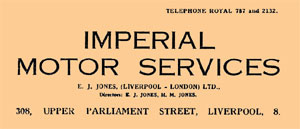
In the early twenties, Welshman Evan James Jones started a general
transport business in Liverpool and by 1925 had branched out into coaching
on a seasonal basis under the name "Imperial Motor Services". Unfortunately
the firm was both poorly managed and funded but it seemed that such was
the demand for transport that success was assured.
Day routes to London were initiated 2nd May 1928 for 17/6d a single
ticket and 30/- return. Leaving Liverpool at 08:30a.m. the route went through
Prescot to Warrington and by way of Prees Heath to Shrewsbury. Then via
Much Wenlock to Stratford On Avon, Woodstock, Oxford, High Wycombe and
Shepherds Bush. This route seemed to avoid the more obvious and direct
A5 which would have passed North of Birmingham. The service was suspended
in the Winter time but resumed 28th March 1929. A night service started
Friday 12th July 1929 leaving at 10:30pm from a terminus at either 23 Mount
Pleasant or 9 St. John's Lane, Liverpool. Imperial was the first of the
Liverpool operators to initiate a night service using conventional coaches.
The night route was initially the same as the day service (The Tourist
Route) but as it was realised that few intermediate passengers were to
be found at night the route changed to the more direct A5 round the top
of Birmingham and this was advertised as the "Night Express".
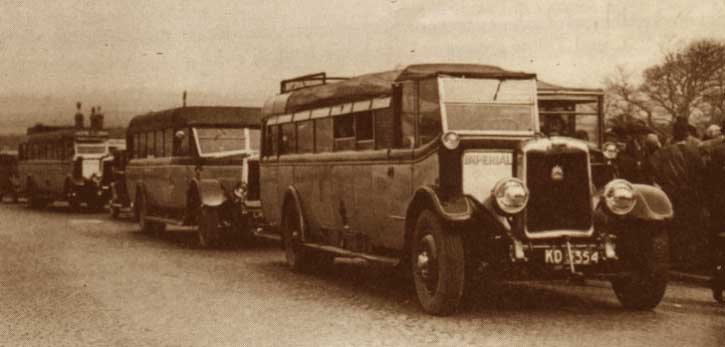
KD 5296 was one of a batch of six Leyland Tigers purchased
by Imperial for their expanding services. Chassis number 60134 was produced
in October 1928 and bodied as a "parlour saloon" by Hoyal of Weybridge.
It was first registered on 27th March 1929 (The day before the 1929 night
service started). The parlour saloon could be described as the ultimate
development of the charabanc for although it had a centre gangway between
the seats and only one entrance door, it still retained a full width folding
canvas roof. This extended over the driver's cab even though he was separate
from his passengers in the half-cab configuration of this design. While
folding roofs might have been fine for Summer touring it cannot have been
the ideal choice for long distance over night travel. Hardy creatures our
forefathers. A solid roof was fitted only over the back seats and this
carried a roof rack reflecting the need for extra luggage capacity on such
a journey. Another anachronism was the fitting of running boards for there
were no doors along the side that required a step. The Tigers were not
consecutively registered probably because they came through as a cancelled
order from Chas. Smith of Blackpool. Two sisters are known to have been
KD 5354 (a TS1) and KD 3627. The other three are unknown. Apparently the
livery of the vehicles while uniform in layout, differed in colours. KD
5296 was Oxford Grey and Mauve but KD 5354 was silver and red. Apart from
Imperial, E.J.Jones also traded under the title of Blue Bird Super Luxury
Saloon Coaches. In October 1931 KD 5296 acquired a blue livery and traces of this have been found on the front axle.
In 1930 E.J.Jones turned the business into a private company, E.J.Jones
(Liverpool London) Ltd. The existing vehicle registration books were updated
to show this change and six new AEC Regals were acquired in 1931. However
by 1934 competition and Legislation was getting the better of this rather
disorganised firm. The Road Traffic Act 1930 regulated both fares and routes
and Jones' approach to both was at best spasmodic. In October 1932 he was
fined a total of £70.10s. 0d. for breach of licence offences throughout
1931 and 1932. This was a large sum at the time and it is interesting to
note that he immediately applied for a refund on road tax for KD 5296 (which
would have returned about £10) and it was not licenced again until
June the following year. During 1933 the AEC Regals were repossessed and
the 1934 service was run by hiring in vehicles from James Pearson's "Happy
Days Motorways". By the end of the year the business had formally been
sold to Pearson. Imperial applied for a road tax refund for KD 5296 in
November 1934. By the time the sale was completed Pearson's was also in
the process of being sold under rather happier circumstances to Crosville
and Ribble.
James Motor Garages
Un-wanted, all the Imperial vehicles passed to dealers and remarkably,
KD 5296 although only five years old began another of the periods of hibernation
that have characterised her life. She languished until 1939 when she was
among several second hand vehicles purchased by James Motor Garage who
were on a much more secure financial footing than Imperial had ever been.
James had interests in car repair and dealerships as well as coach operation.
On their letter head they listed four Liverpool locations for a variety
of different activities in the motor trade. "Home James Coachways" operated
from 319 Scotland Road and it was from here that she was driven down to
the Hove factory of Thomas Harrington Coachbuilders to have the now extremely
old fashioned Hoyle body replaced. It is known that the driver who took
the vehicle to Hove died in 1994 but unfortunately this was before he could
be contacted to see if he remembered the journey.
James Garages were fortunate to be able to cash in on a well known phrase when they called their coaching business "Home James". In fact a search of the internet will reveal that even in this day and age it remains a popular term in connection with chauffeur driven hire cars. It has not been possible to find an actual incident that might have introduced the phrase into popular parlance. Dating back into the nineteenth century the complete saying is: "Home, James, and don't spare the horses!". This would be directed at the coachman, usually by merry revellers just emerging from a "jolly good night out". It is likely there were references to the phrase in music hall entertainment and it is believed a recording of the title was made during the 1930s which gave new popularity to the saying.
The new body style was an "Observation saloon". The title primarily applied to a patented Harrington feature where the coach floor rose progressively towards the back of the coach, thus allowing passengers a better view over the heads in front. However, the term might equally well apply to the large canvas sun roof. The canvas was supported by ash hoops across the opening which all moved back along a track by turning a handle in the cab. The material gathered together
at the back of the roof rather like a camera bellows. The hoops were hidden to view from the inside by a by a covering skin of different colours of rexine made into a decorative pattern. This also folded up when the roof was open.
Although there were several variations of the Observation Saloon body, the one fitted to
KD 5296 is perhaps the ultimate development; introduced in 1938 and known as the "torpedo" - a term by then less used in Britain but still fashionable on the Continent to describe a streamlined touring car.
Quite rightly, the late 1920s and 30s have come to be regarded as a tremendously innovative period for
fashion and style. Industry and Art (especially art deco) drew inspiration from each other. It is said that Parry Thomas, Leyland's chief designer finally hit on the shape for the headlights on the Leyland 8 limousine by copying his wrist watch. The designers of the time
were very well aware of each others activities. With regard to influences in coach design, it is interesting to speculate
where the styling cues came from. It was the era of speed
and streamlining. Record breaking machinery was headline news. Malcolm
Campbell's epoch marking
300 mph Bluebird of 1935 featured an enormous fin which was virtually the
whole back end of the car. Furthermore the car was nearly as long as a
coach and boasted a similar number of wheels!
The final version of the
Observation Saloon, the "torpedo", as fitted to KD 5296 departed from the normal Harrington
features which had the rear wheel arches sweeping down to the rear bumper
line. Instead the style dispensed with the straight stepped waist rail
and was altogether more rounded. The rear wheel arches were bulbous and
set the style for certain models that would appear in the 1950's. Presumably
to provide a clean line, Harrington left off the small vent at the side
of the cab roof and the characteristic water gutter over the destination
windows. These features are so synonymous to Harrington bodies that some
observers have supposed that in the case of KD 5296 they must have been
removed by later owners, but not so. The sloping rear dome is somehow reminiscent
of the "Coronation" Observation cars introduced by Sir Nigel Gresley for
the highly publicised L.N.E.R. Silver Link train in 1937. It is entirely
possible that Harringtons hoped to capture some of the excitement created
by these trains as much as they wished to connect the dorsal fins with
the Land Speed Record cars. In an age before mass car ownership there was
a great deal of kudos attached to travelling in vehicles which were the
very height of fashion.
Any vehicle that survived the war must be viewed with a certain amount
of wonder. If KD 5296 had not recently been re bodied it would almost certainly
have met it's end in the scrap drive to produce weapons. As it was, Liverpool
was subject to regular heavy air raids particularly around the port and railways
and the survival of motor vehicles abandoned as their owners took to the
shelters was largely a matter of luck. Nothing is known about the activities
of KD 5296 during the war years. Certainly, unlike many other coaches she
was never requisitioned by the War Department and remained with Home James
for the duration. It is reasonable to speculate that she was involved in
moving troops around the busy city.
According to the registration book the tax that expired in June 1950
was the last and she was laid up. For some reason the Liverpool City Treasury
Motor taxation department was moved to write to Home James Garages in November
1954, to which James replied, simply stating that KD 5296 was still in their possession. Had she been out and about, one wonders?
Historical researchers are able to chart
the movements of vehicles with remarkable accuracy because up until the late 1960s the vehicle registration book ("log" book) was always dated and stamped with the issuing authorities location when road tax was purchased. Unfortunately the movements
of KD 5296 after 1950 can only be chronicled by individual's personal recollections.
Preservation
In the 1960's Home James got into financial difficulties and decided
to sell a number of vehicles.
By 1965, KD 5296 and another vehicle (variously reported as an Alexander
bodied Tiger PS or a Tilling Stevens) had been standing in James' depot
so long that when the time came to move them it was found that they were
effectively bricked in by new building work. In the end they were extracted
with a crane during which process the rain gutter over the cab door was
damaged and the offside front wing dented. At this point the timing of
events becomes a little confused. One source of information has it that
in the late sixties the two coaches were sent to auction at Battersby's Garage in Morcambe and
went their different ways. KD 5296 apparently was purchased by
the late Stuart Rutherford who ran Earnside Coaches at Glenfarg, just South of Perth.
However his son David who now runs the business recollected that they bought
KD 5296 from coach operators and dealers Florence & Grange at Morecambe
in 1978 during a "shopping trip" for some modern vehicles. So it could
be that there was another owner after Home James but before the coach went
to Scotland. Certainly there is a bit of a mystery as to how the engine appears to be so clean all over the exterior and apparently in good running condition. David Rutherford says that while with Earnside coaches only the
magneto was removed and serviced but apart from
this nothing else was done. She was parked in a shed, although this was
open at one end. Stuart Rutherford did not update the registration of the
vehicle to his name. According to David, KD 5296 stayed approximately two years
in Scotland which would have made the date of sale 1980. Frank Elliot of
Warrington, who was the next owner, is unable to confirm the exact date
and since the vehicle was hardly road worthy he did not put his name to
the registration document either. I think it is fair to say that since
none of the owners were actually taking precise notes at the time it is
inevitable that the versions are slightly vague. In April 1982 when a new
computerised registration system was set up, Frank took care to register
the vehicle with the DVLC at Swansea and a V5 document was obtained. Fortunately,
the original log book, last used in 1950 was kept with the vehicle. Once
again she went back into into dry storage hibernation.
Back in Liverpool, "Toppings' Super Coaches" took over Home James Coachways in 1978. They
did not totally discard the old name, sign writing their coaches "Topping's
Home James". (Later still another long established Liverpool operator, "Crown" coaches was acquired and added on to the end of the now rather cumbersome title). The Topping fleet had a particular leaning
towards Harrington bodies and Leylands if possible. They thought it would
be nice to bring KD 5296 and the name Home James back under one roof and
they later approached Frank Elliot several times with a view to purchasing
KD 5296. Elliot always declined.
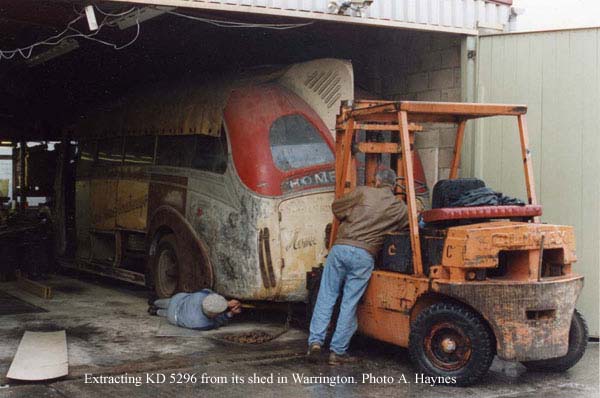 During 1994, deciding that he was never going to see through the restoration
of KD 5296 Frank Elliot decided to sell and advertised in the Historic
Commercial Vehicle Society's newsletter. Two adverts were placed, the first
containing errors. After a possible deal with a man from Australia fell
through it was sold to Allan Haynes in October. The present owner also
telephoned Frank Elliot but was too late. Haynes had the vehicle taken
by low loader to a building he had with the Eastern Transport Collection
near Attleborough, Norfolk. His first efforts were to have all the springs
re set and the tyres replaced with new ones. Now at least it rolled easily.
In fact too easily for it had no brakes at all. Attempts to start the engine
were thwarted by water leaks from a corroded engine casting cover and a radiator
elbow in the cooling system.
During 1994, deciding that he was never going to see through the restoration
of KD 5296 Frank Elliot decided to sell and advertised in the Historic
Commercial Vehicle Society's newsletter. Two adverts were placed, the first
containing errors. After a possible deal with a man from Australia fell
through it was sold to Allan Haynes in October. The present owner also
telephoned Frank Elliot but was too late. Haynes had the vehicle taken
by low loader to a building he had with the Eastern Transport Collection
near Attleborough, Norfolk. His first efforts were to have all the springs
re set and the tyres replaced with new ones. Now at least it rolled easily.
In fact too easily for it had no brakes at all. Attempts to start the engine
were thwarted by water leaks from a corroded engine casting cover and a radiator
elbow in the cooling system.
In conversation at the LBPT's Cobham open day in April 1995 the present owner learned that
Allan Haynes had also acquired DKT 16, the ex-Maidstone & District
Harrington bodied Leyland TS7 and that this and KD 5296 were both now up
for sale. That evening a telephone call led to the disappointing information
that although both were advertised he actually only intended to sell only
one and DKT had gone first. Never the less, such is the present owner's
interest in Harringtons that a visit was arranged for the following weekend to photograph the vehicle.
Allan Haynes was actually looking for a vehicle he could use on PSV
heritage tours around the area of his home in Norfolk. Unfortunately it
was looking like KD 5296 was rather further away from being ready for this
than he had imagined. This too had been the case with DKT 16 which he had
sold again. His initial thoughts were to keep working on KD 5296 but hopes
of catching the Summer 1995 season were rapidly fading. Accordingly KD
5296 passed to the present owner in May 1995. She stayed in Norfolk for
the next two months until with the kind assistance of Brentwood Coaches
she was taken by low loader to Mangapps Farm Railway Museum at Burnham
on Crouch. At this time, Brentwood Coaches had a large collection of preserved
coaches and by coincidence earlier that year had purchased a Leyland
PS1/ Harrington, JYC 855 from Toppings - the firm that had aquired the Home James name in 1978. Toppings were ceasing trading due to
illness.
At Mangapps the water leaks were repaired and the sump let down for
inspection. Everything inside the engine appeared in very good condition
and the opportunity was taken to clean the inside of the crankcase and
the felt oil filter in the sump. The fuel tank had rusted through to holes
but with the autovac topped up with petrol, just a few turns of the handle
coaxed the engine into life. During this time I suppose technically KD 5296 attended its first rally, motoring out of its storage shed into a nearby paddock during the end of season "Thomas the Tank Engine" event. It managed to avoid a plywood face being fixed to the radiator. The stay at Mangapps was from the outset only
intended to be temporary and Brentwood Coaches again provided the means
to move KD 5296 to Castle Point Transport Museum in March 1996.
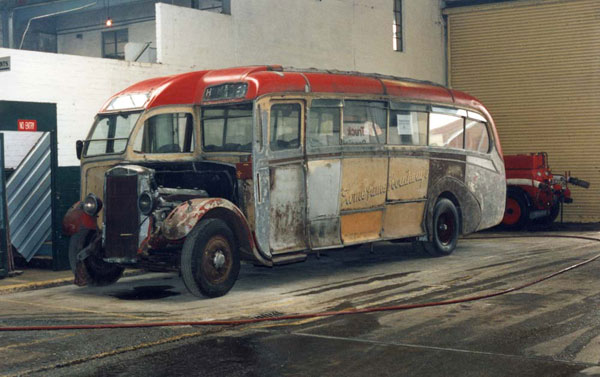 KD 5296 arrived at C.P.T.M.S. in time for the April 1996 open day. By
a remarkable chance a Scottish visitor remembered seeing her in Scotland
and provided information about Earnside Coaches. She proved to be a major
attraction and the engine was run up several times during the day, causing
a mass of people to assemble each time. Attention to a broken spring
in the Autovac meant that she could now suck fuel from a can.
KD 5296 arrived at C.P.T.M.S. in time for the April 1996 open day. By
a remarkable chance a Scottish visitor remembered seeing her in Scotland
and provided information about Earnside Coaches. She proved to be a major
attraction and the engine was run up several times during the day, causing
a mass of people to assemble each time. Attention to a broken spring
in the Autovac meant that she could now suck fuel from a can.
Due to the number of vehicles in restoration at Canvey and subsequent pressure on space, before admittance, C.P.T.M.S. made a requirement that no significant work be done to KD 5296 until a "dirty" area was vacated by a finished project. This meant that generally work was limited to conservation and general maintenance. In the years ahead events were to unfold that meant in retrospect it was fortunate that the coach remained mobile and in one piece.
Before this though there was another target. KD 5296 attended her first rally. In June 1997 there was a special Harrington Gathering to celebrate 100 years since Harrington started coach building. This was held at Amberley Chalk Pits Museum in Sussex. Of course the only way that she was able to attend was to been taken by low loader and many thanks go to Steve Rowland Commercials for facilitating this.
Read an article about KD 5296 at Harrington 100
In September 1999 KD 5296 was once again on the move. Problems with accomodating the height of another vehicle (Foden VRF 372) meant that space at Castle Point Transport Museum had to be used for the Foden and KD was moved to the private accomodation that was originally intended for the Foden. This too was a short lived arrangement as a year later a work related house move meant that the owner's whole collection eventually migrated to new accomodation in Norfolk. With KD 5296 and others no longer accessible to the public in an established museum it was decided that at the very least the collection could be available to enthusiasts by appointment and the idea for the TH Collection was born.
View items discovered inside KD 5296.
 TH Collection index
TH Collection index  Entrance Hall
Entrance Hall


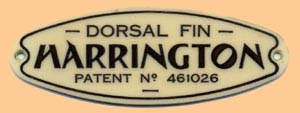
 During 1994, deciding that he was never going to see through the restoration
of KD 5296 Frank Elliot decided to sell and advertised in the Historic
Commercial Vehicle Society's newsletter. Two adverts were placed, the first
containing errors. After a possible deal with a man from Australia fell
through it was sold to Allan Haynes in October. The present owner also
telephoned Frank Elliot but was too late. Haynes had the vehicle taken
by low loader to a building he had with the Eastern Transport Collection
near Attleborough, Norfolk. His first efforts were to have all the springs
re set and the tyres replaced with new ones. Now at least it rolled easily.
In fact too easily for it had no brakes at all. Attempts to start the engine
were thwarted by water leaks from a corroded engine casting cover and a radiator
elbow in the cooling system.
During 1994, deciding that he was never going to see through the restoration
of KD 5296 Frank Elliot decided to sell and advertised in the Historic
Commercial Vehicle Society's newsletter. Two adverts were placed, the first
containing errors. After a possible deal with a man from Australia fell
through it was sold to Allan Haynes in October. The present owner also
telephoned Frank Elliot but was too late. Haynes had the vehicle taken
by low loader to a building he had with the Eastern Transport Collection
near Attleborough, Norfolk. His first efforts were to have all the springs
re set and the tyres replaced with new ones. Now at least it rolled easily.
In fact too easily for it had no brakes at all. Attempts to start the engine
were thwarted by water leaks from a corroded engine casting cover and a radiator
elbow in the cooling system.
 KD 5296 arrived at C.P.T.M.S. in time for the April 1996 open day. By
a remarkable chance a Scottish visitor remembered seeing her in Scotland
and provided information about Earnside Coaches. She proved to be a major
attraction and the engine was run up several times during the day, causing
a mass of people to assemble each time. Attention to a broken spring
in the Autovac meant that she could now suck fuel from a can.
KD 5296 arrived at C.P.T.M.S. in time for the April 1996 open day. By
a remarkable chance a Scottish visitor remembered seeing her in Scotland
and provided information about Earnside Coaches. She proved to be a major
attraction and the engine was run up several times during the day, causing
a mass of people to assemble each time. Attention to a broken spring
in the Autovac meant that she could now suck fuel from a can.
